
About UsThe Numismatic Bibliomania Society is a non-profit organization promoting numismatic literature. For more information please see our web site at coinbooks.org SubscriptionsThose wishing to become new E-Sylum subscribers (or wishing to Unsubscribe) can go to the following web page link MembershipThere is a membership application available on the web site Membership Application To join, print the application and return it with your check to the address printed on the application. Membership is only $15 to addresses in the U.S., $20 for First Class mail, and $25 elsewhere. For those without web access, write to: David M. Sundman, Secretary/TreasurerNumismatic Bibliomania
Society AsylumFor Asylum mailing address changes and other membership questions, contact David at this email address: dsundman@LittletonCoin.com SubmissionsTo submit items for publication in The E-Sylum, just Reply to this message, or write to the Editor at this address: whomren@coinlibrary.com
BUY THE BOOK BEFORE THE COINYou won't regret it! |
- WAYNE'S WORDS: THE E-SYLUM APRIL 19, 2009
- THE ASYLUM, VOLUME 27, NO. 1
- KARL MOULTON'S SPRING/SUMMER 2009 NUMISMATIC LITERATURE LIST
- NEW BOOK: GUIDE BOOK OF THE OFFICIAL RED BOOK OF UNITED STATES COINS
- KEN BRESSETT ON R.S. YEOMAN AND HIS CLASSIC GUIDE BOOK
- MONEYMAKERS: THE SECRET WORLD OF BANKNOTE PRINTING BY KLAUS BENDER
- BOOK IN PROGRESS: THE HISTORY OF THE MORRISTOWN MINT BY MICHAEL HODDER
- ANS LIBRARIAN TO SPEAK AT CHICAGO INTERNATIONAL COIN FAIR
- CONDER TOKEN COLLECTORS JOURNAL SPRING 2009 ISSUE
- QUERY - WHAT IS THE GREAT DEPRECIATION?
- QUERY: RELIC MEDALS
- QUERY: OMAHA BANK HOARD
- QUERY: IN GOD IS OUR TRUST
- QUERY: NUMISMATIST WILLIAM P. BECK
- THOUGHTS ON DETECTING COUNTERFEIT COINS BY THEIR SOUND
- VOCABULARY WORD: BRUMAGEM OR BRUMMAGEM
- MORE ON THE MAUNDY MONEY CEREMONY
- WHY PRESIDENT JOHN ADAMS IS DEPICTED ON AN ALASKA STATEHOOD MEDAL
- A PICTURE OF THE HORSE NAMED NUMISMATIST
- MORE ON THE 1888 RUGBY MEDAL
- EDUCATING BANK TELLERS AND THE PUBLIC ABOUT COINS AND PAPER MONEY
- ALL THINGS CONSIDERED INTERVIEWS U.S. MINT ARTISTS
- COIN WORLD ON ELECTRONIC PUBLISHING OF NUMISMATIC LITERATURE
- NEW E-BOOKS: KRAUSE PUBLICATIONS' WORLD COIN MICRO-CATALOGS
- MORE ON THE DIGITAL DILEMMA
- ARTICLE PROFILES THE 1968 PENNY MAN
- NEW LINCOLN CENT DESIGNS SLOW TO ENTER CIRCULATION
- AUSTRALIAN SHOPKEEPERS WANT TO DITCH THE NICKEL.
- RAE V. BIESTER, PHILADELPHIA MINT SUPERINTENDENT
- ANOTHER SOLAR-SYSTEM MEDAL
- BOOK LOOTED IN CIVIL WAR RETURNED TO LIBRARY AFTER 145 YEARS
- FEATURED WEB SITE: ISLAMIC BANKNOTES
WAYNE'S WORDS: THE E-SYLUM APRIL 19, 2009
 We now have 1,229 subscribers. No one new to report this week. Who's got a friend who would enjoy reading The E-Sylum?
We now have 1,229 subscribers. No one new to report this week. Who's got a friend who would enjoy reading The E-Sylum?Rich Mantia writes:
The fact that an issue was late is not as important as recognizing that you work so hard for the benefit of us all. It's true that the subscribers volunteer stories and comments, but without your efforts nothing would be done. I appreciate ALL that you do and I hope that you desire to do it for a long time.
I think it's numismatist Jerry Kochel who often says, "The harder I work the behinder I get". I'm so busy and "behind" on things these days I figure that on sheer momentum alone I'll be dead for a week before I finally get around to falling over. But I always try to squeeze in some time for The E-Sylum. It is a lot of work, but it's a lot of fun as well.
It's my connection to the hobby and all of my great numismatic friends out there. I wouldn't feel like doing it if it weren't for the support of my readers. I expect I'll keep it up as long as I can find something interesting to write about, which never seems to be a problem with this great hobby of ours.
In all the confusion of wrestling with the mailing list I apparently messed up the issue numbering in the last two emails; thanks for Arthur Shippee for pointing it out. Bruce Perdue has corrected these in our web archive and hopefully, we're back on track this now. This is volume 12, number 16.
On another topic, I was helping my son Tyler with his homework after school one afternoon this week. One of his study questions was on the storytellers of Mali. He knew the answer - that the storytellers were responsible for handing history and stories down from generation to generation.
I told him that memory and storytelling were the only means the people had to do that, since they didn't have books. I pointed to a book on my shelf and asked him when it had been printed. Easy enough - on the spine of the bookbox of Barton's Life of Rittenhouse is printed the date 1813.
When I take that book off my shelf and read it, I told him, I'm hearing the story of a famous man's life told to me by the author who wrote the book nearly 200 years ago - an author who knew about him, read his letters, and talked to his friends and relatives. Without that book, we'd know a lot less about him today.
Then, referring to the book, Tyler said, "and you're going to pass it on to someone else, right?"
Indeed I will. We collectors know we are merely curators who, like the storytellers of Mali, will pass on their treasures to the next generation. I thought it was a remarkably mature insight for an eight-year-old who only last Sunday saw a light on at 4am and was beside himself with excitement thinking he'd spotted the Easter Bunny.
This week we open with information on the latest issue of our print journal, The Asylum, and the new "Guide Book of the Guide Book" from Whitman. Next up is a not-so-new-anymore book on the banknote printing industry and an old-but-soon-to-be-new-again book on the Morristown Mint.
Other topics include relic medals, the "Omaha Bank hoard", the motto "In God is Our Trust", and new e-books from Krause Publications. Quick, what's a "Brumagem", and how is the term used in numismatics? To learn what dental tools, Shrek and Michelangelo's David have to do with the U.S. Mint, read on. Have a great week, everyone!
Wayne Homren
Numismatic Bibliomania Society
THE ASYLUM, VOLUME 27, NO. 1
The editor of our print journal, David Yoon writes:- Leonard Augsburger: The One Hundred Greatest Items of United States Numismatic Literature: A Survey of the Numismatic Bibliomania Society, Part 1
- Max B. Spiegel: A Visit to the Historic Mehl Building
- John W. Adams: Observations on Two Recent Sales
- RyAnne Scott: News from the ANA Library
Although The E-Sylum is free to all, only paid members of the Numismatic Bibliomania Society receive The Asylum. You're missing out if you're not a member! To join, see the membership information at the top right section of this and every E-Sylum issue.
KARL MOULTON'S SPRING/SUMMER 2009 NUMISMATIC LITERATURE LIST
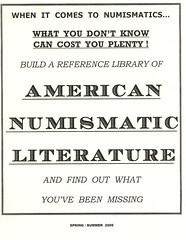 Numismatic literature dealer Karl Moulton of has published his latest fixed price list, the Spring / Summer 2009 issue. It features 47 pages of listings of numismatic auction catalogs, periodicals and books.
Numismatic literature dealer Karl Moulton of has published his latest fixed price list, the Spring / Summer 2009 issue. It features 47 pages of listings of numismatic auction catalogs, periodicals and books. NEW BOOK: GUIDE BOOK OF THE OFFICIAL RED BOOK OF UNITED STATES COINS
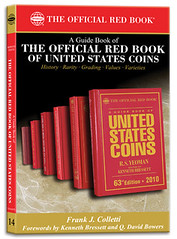 Whitman Publishing entered the field of numismatic publishing in 1934. In 2009 the company celebrates its 75th year with a book about the hobby’s leading annual reference—the Guide Book of United States Coins, popularly known as the “Red Book.”
Whitman Publishing entered the field of numismatic publishing in 1934. In 2009 the company celebrates its 75th year with a book about the hobby’s leading annual reference—the Guide Book of United States Coins, popularly known as the “Red Book.”Over time the Red Book, which has been a cornerstone of the hobby since it debuted in late 1946, has become a collectible itself. Many coin collectors save a copy each year, while striving to hunt down the elusive early editions and rare errors and varieties.
To assist other collectors, researcher and longtime hobbyist Frank J. Colletti has written the definitive guide to the scarlet tome: the Guide Book of the Official Red Book of United States Coins.
A reader needn’t be a confirmed “numismatic bibliophile” to love this book—just a fan of the world’s greatest pastime. It’s unlikely that any coin collector active today has not heard of the hobby’s beloved “Red Book.” Collectors have bought more than 22 million copies since 1946, making it one of the best-selling nonfiction books in the history of American publishing.
 The Guide Book of the Official Red Book of United States Coins offers a history of earlier coin price guides. Colletti explores the foundation laid by hobby legend R.S. Yeoman with the “Blue Book” (which debuted in 1942, and compiled dealers’ buying prices).
The Guide Book of the Official Red Book of United States Coins offers a history of earlier coin price guides. Colletti explores the foundation laid by hobby legend R.S. Yeoman with the “Blue Book” (which debuted in 1942, and compiled dealers’ buying prices). He then studies each Red Book issued since 1946. Regular editions, special editions, authorized overprint editions, and amazing errors are all examined in detail, with market values given for various grades. Colletti tells what to look for and how to build and care for a collection of Red Books. He also discusses Red Book–related medals and other collectibles.
Along the way, the reader will enjoy a wealth of old advertisements, vintage photographs of the personalities involved in the book, and historical hobby memorabilia. Kenneth Bressett, Q. David Bowers, and other famous hobbyists offer their personal recollections. In pictures and words, it’s like sitting down with friends and learning all the behind-the-scenes stories, the legends, and the lore of more than 60 years of American numismatics.
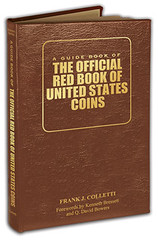 Everyone who collects or deals in rare coins, numismatic literature, or collectible books—or loves learning about the hobby’s famous dealers, collectors, and researchers—as well as those who want to add to their own collection of Red Books, or find out how much they’re worth—will be delighted with the Guide Book of the Official Red Book of United States Coins.
Everyone who collects or deals in rare coins, numismatic literature, or collectible books—or loves learning about the hobby’s famous dealers, collectors, and researchers—as well as those who want to add to their own collection of Red Books, or find out how much they’re worth—will be delighted with the Guide Book of the Official Red Book of United States Coins.Available online, including at at www.WhitmanBooks.com; and in bookstores and hobby shops nationwide.
By Frank J. Colletti. Forewords by Kenneth Bressett and Q. David Bowers.
304 pages; full color; 6 x 9; softcover. Retail $19.95.
A leather-bound Limited Edition (250 copies, autographed by the author) is available for $49.95.
KEN BRESSETT ON R.S. YEOMAN AND HIS CLASSIC GUIDE BOOK
Yet that is just what has happened to this unique coin reference. It is probably every author’s dream that their published work will pass the test of time, but few books have ever achieved the longevity of what has turned out to be the world’s most popular coin price guide.

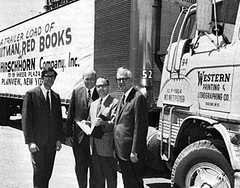
It was my pleasure to have known R.S. Yeoman from my early days in numismatics, in 1948, to the time of his death 40 years later. My respect for him never wavered. He was a man of the highest integrity, gentle, thoughtful of others, and a keen businessman. His understanding of coin collectors kept him always in tune with their needs and wishes. It was his desire to provide collectors with products that were as precise as possible, sparing no effort to give unbiased pricing information and up-to-date numismatic information.
The story of A Guide Book of United States Coins as told by Frank Colletti in this fascinating account is not merely a story about those who produced it, but a tribute to the thousands of individual contributors who have honed its contents to the point that it has become a numismatic standard and a valuable collectible in its own right. It is a success story that remains unparalleled by any other similar book.
To read the complete article, see: The Most Admired Book in Numismatics (www.whitmanbooks.com/Default.aspx?Page=55&HTMLName=ReviewGuest_0409)
MONEYMAKERS: THE SECRET WORLD OF BANKNOTE PRINTING BY KLAUS BENDER
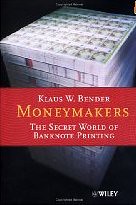 I don't think we've discussed this book before. Published in 2006, Moneymakers by Klaus Bender covers the secretive world of banknote printing. The author makes a number of strong claims. For example, the following is from the inside dust jacket flap (as found on Amazon.com):
I don't think we've discussed this book before. Published in 2006, Moneymakers by Klaus Bender covers the secretive world of banknote printing. The author makes a number of strong claims. For example, the following is from the inside dust jacket flap (as found on Amazon.com):Moneymakers has been researched over a five-year period in Europe, the USA and Latin America. The book is based exclusively on personal interviews and confidential material normally not accessible to outsiders. There were attempts to stop this research project. Many witnesses interviewed spoke under condition of strict confidentiality for fear of reprisals by their employers. As a rule therefore, the author refrained from verbatim quotes and, as far as possible, tried to confirm every piece of information by two independent sources.
Wondering which American author was being referred to, I asked Gene Hessler, who writes:
BOOK IN PROGRESS: THE HISTORY OF THE MORRISTOWN MINT BY MICHAEL HODDER
Members of the Colonial Newsletter Foundation (CNLF) are currently reviewing a draft of Michael J. Hodder's manuscript The History of the Morristown Mint 1786-1788: A Study of a Confederation Period Coinage.James Spilman writes:
I asked Mike Hodder about the project. He writes:
I spent my days in the county archive reading through bundles of court papers that hadn't been opened since the late 1780's. I wrote a short summary for The Numismatist and submitted the first couple of chapters to the ANS, which turned out not to be interested. Remember, this came at a time when the institution's focus was on the numismatics of antiquity.
I gave the manuscript to Jim Spilman years ago, and he asked if he could publish it as a technical note and I gave my OK. Although it was unfinished and unpolished, there may be something in it that might be useful to some. My goal was to place Walter Mould's coinage operation into its social setting. He had his own powerful backers, particularly among the civil administrative officers in Morris County.
Jim's goal has been to turn the manuscript into an eBook for use of CNLF researchers. He writes:
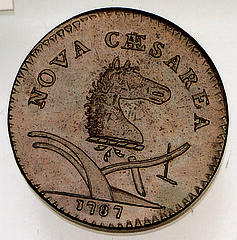
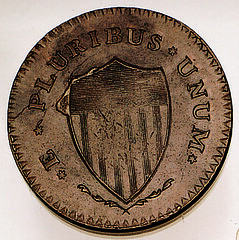
Hodder cataloged examples of the coins Morristown Mint coins in the recent Stack's sales of the John J. Ford collection. With permission from Stack's, shown above are images of lot 198 from the Ford I sale, courtesy of Vicken Yegparian at Stack's.
THE BOOK BAZARRE
ANS LIBRARIAN TO SPEAK AT CHICAGO INTERNATIONAL COIN FAIR
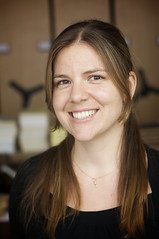 According to the ANS E-NEWS for April 2009,
According to the ANS E-NEWS for April 2009, The CICF web site provides this information about the talk:
This talk will use Homer’s mention of the island “thrinakia,” identified as the island of Sicily, as a starting point to discuss the attraction of Sicily and in particular the numerous ancient sites that are preserved throughout the island.
Like the three promontories of Sicily, this talk will have three points that discuss the ANS Library collections, Sicilian history, and early numismatic literature. Examples of early Sicilian numismatic literature will be drawn from the ANS Library in an effort to emphasize the rich and varied nature of the collections.
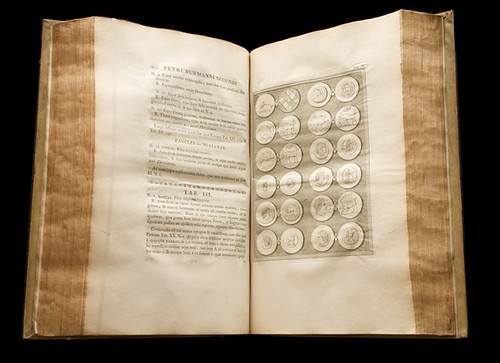
Orville, Jacques Philippe d'. Sicula quibus Siciliae veteris rudera... Amseterdam, 1764.
To visit the Chicago Coin Club web site, see: www.chicagocoinclub.org
CONDER TOKEN COLLECTORS JOURNAL SPRING 2009 ISSUE
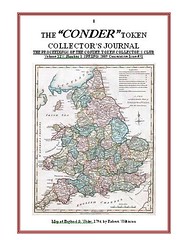
- Token Tales by R.C. Bell
- 2009 Seattle Congress by Bill McKivor
- Lost and Found: One Scepter by Tony Fox
- 2009 CTCC Elections
- DNW Auction Report by Peter Preston-Morley
- Suffolk 15 by Tony Fox
- The Library, Part 4 by Richard Samuel
- Six New Varieties of Camac Tokens by Gregg Silvis of Camac Tokens
- Seventeenth Century Tokens by Fred Burgess
QUERY - WHAT IS THE GREAT DEPRECIATION?
Last week Dan Owens submitted an item related to the famous counterstamps of druggist J. L. Polhemus. The following appeared in the San Francisco Bulletin on May 29th, 1859: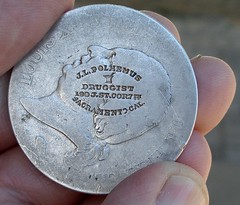
Since then the coin has greatly depreciated, and it is said that a cunning financier in Sacramento, is, and has been, engaged for some time in collecting all francs and forty-cent pieces containing the Polhemus stamp, intending to make him redeem them at the rate they were current at when he put his endorsement upon them;
Tom DeLorey writes:
QUERY: RELIC MEDALS
Don Cleveland writes:QUERY: OMAHA BANK HOARD
Dave Bowers forwarded this query from a correspondent who writes:QUERY: IN GOD IS OUR TRUST
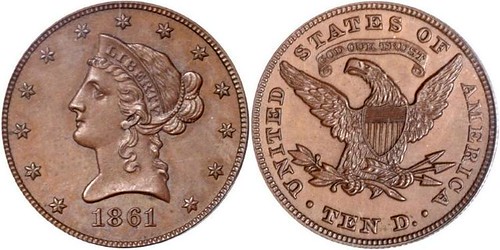
In both the correspondence between the Secretary of the Treasury and the Director of the Mint in the early 1860s as well as everything I have read in numismatic publications, that phrase is always traced back (only) to 1814 and F. S. Key’s lyrics for the Star Spangled Banner. In the fourth and final verse Key used that exact phrase. I have never come across any references to its usage before 1814. I had therefore always assumed Key composed the phrase as he wrote the lyrics.
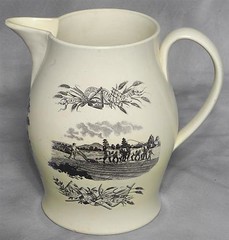 The Jan. 2009 Stack’s auction of Americana included a small group of Creamware pitchers from England. Lot 6125 pictures and describes a pitcher dated to 1800 (not circa 1800) that carries that exact phrase. This raises the obvious question of whether Key used a phrase already in usage in England or the pitcher dates to later than 1814 or whether by pure coincidence he happened to select those precise same words.
The Jan. 2009 Stack’s auction of Americana included a small group of Creamware pitchers from England. Lot 6125 pictures and describes a pitcher dated to 1800 (not circa 1800) that carries that exact phrase. This raises the obvious question of whether Key used a phrase already in usage in England or the pitcher dates to later than 1814 or whether by pure coincidence he happened to select those precise same words. This is my basic point: If that five word phrase was already being used in England, the story of the derivation of our National Motto needs to be traced back to its roots rather than just to 1814.
Before sending this message to you, I have raised these points and questions with Dave Bowers, Joel Orosz, Leonard Augsburger, John Adams, and David Alexander who catalogued the pitcher for Stacks. In addition I attempted an Internet search, neither of which yielded anything appropriate. My hope is that you would present this matter to your readers to see if anyone can shed light on the origin and use of “In God Is Our Trust” in England, before 1814, or both.
The pattern coin pictured above is J285 / P340 from the www.uspatterns.com web site. The pitcher image is from the Stack's web site. -Editor
QUERY: NUMISMATIST WILLIAM P. BECK
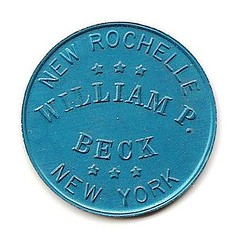

I would like to hear from anyone who remembers him. Even better, I would like a reference to his name appearing somewhere in print related to numismatics.
THOUGHTS ON DETECTING COUNTERFEIT COINS BY THEIR SOUND
Tom DeLorey writes:
Joe Boling writes:
VOCABULARY WORD: BRUMAGEM OR BRUMMAGEM
Brumagem is italicized in the text. I looked in Nipper's In Yankee Doodle's Pocket book and the term is not in the index. A net search has the term spelled Brummagem. Apparently, this is a reference to imitation coppers in circulation circa 1790, the term appropriated from the British. See: www.phrases.org.uk/bulletin_board/17/messages/821.html
www.1911encyclopedia.org/Brummagem
It's interesting to see the term was still in use in 1850. For more information on Lord Timothy Dexter, if only to amuse yourself, go to www.lordtimothydexter.com
Anyway, the first web page Dick referenced includes this definition from Merriam-Webster: -Editor
By the 19th century, Birmingham had become a chief manufacturer of cheap trinkets and gilt jewelry, and again the word "brummagem" followed suit--it came to describe that which is showy on the outside but essentially of low quality.
Perhaps the term was something of an annoyance to the people of Birmingham way back when, but nowadays "brummagem" is usually used without any conscious reference to the British city.
MORE ON THE MAUNDY MONEY CEREMONY
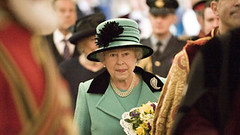 A number of years ago, we heard an interesting story while staying in a Bed & Breakfast in a private home in the South East of Great Britain. The son of our host family had been selected (along with a girl) to serve with Queen Elizabeth II as the ancient Maundy Money ceremony had been celebrated in their town that year.
A number of years ago, we heard an interesting story while staying in a Bed & Breakfast in a private home in the South East of Great Britain. The son of our host family had been selected (along with a girl) to serve with Queen Elizabeth II as the ancient Maundy Money ceremony had been celebrated in their town that year.Of course they were so proud of his selection, and they mentioned all the categories that had been considered: His scholarship, citizenship, patriotism, letters from sponsors, as they went on about how particular the committee was, ensuring that the queen had only the choicest of children in England. "Of course, no Tall Children were eligible, for they dare not have anyone in the ceremony who was over 5'4", (the queen's height."
Having gone through those childhood years as a tall boy, somewhat self-conscious about being clumsy, etc, I felt so sorry that the tall British children were not even considered for the honor! Perhaps, things are handled differently these days?
To read the earlier E-Sylum article, see: QUEEN DISTRIBUTES COINS IN TRADITIONAL MAUNDY THURSDAY CEREMONY (www.coinbooks.org/esylum_v12n15a05.html)
WHY PRESIDENT JOHN ADAMS IS DEPICTED ON AN ALASKA STATEHOOD MEDAL
Dave Lange writes:
The Adams medal has a plain border, while the Alaska medal has a beaded border, and that tells me that this is most likely a mule - whether an authorized muling or a clandestine product is anyone's guess. I'll be interested to read what Dick Johnson has to say about it.
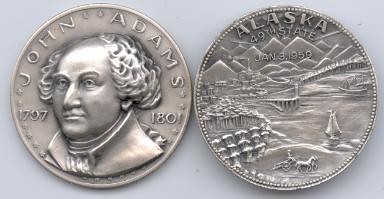
Anne E. Bentley of the Massachusetts Historical Society writes:
So here it is: if you go online to Google Scholar and locate the Boston Alaskan, vol. 1 August 1906-June 1907, edited by L.M. Norton (Boston-Alaskan Society: Boston, 1907) on page 11 you can find a quotation by John Adams that Senator Charles Sumner used during his speech to advocate the acquisition of Alaska…
"Thirteen governments founded on the natural authority of the people alone, without a pretense of miracle or mystery, and which are destined to spread over the northern part of that whole quarter of the globe, are a great point gained in favor of the rights of mankind." John Adams, "Defense of American Constitutions," January 1, 1787. [my italics, AEB]
Sounds reasonable to me. Thanks Adams Papers staff!
A PICTURE OF THE HORSE NAMED NUMISMATIST
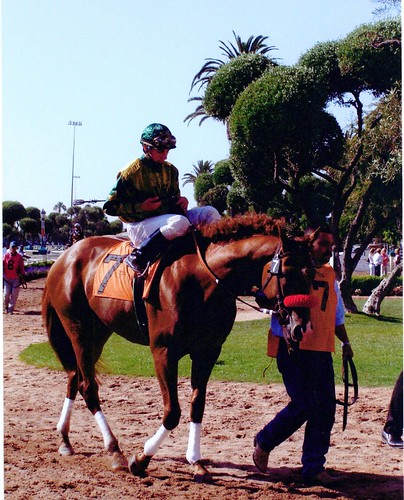
MORE ON THE 1888 RUGBY MEDAL
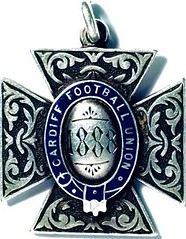 Martin Purdy writes:
Martin Purdy writes: Gwyn Prescott, who has researched the history of rugby in Cardiff in the 19th century, identified it as a medal marking the victory of Penarth in the 1888 Cardiff Football Union Cup final.
To read the previous E-Sylum article, see: ARTICLE AND WEB SITE HIGHLIGHT 1888 RUGBY MEDAL (www.coinbooks.org/esylum_v12n15a26.html)
EDUCATING BANK TELLERS AND THE PUBLIC ABOUT COINS AND PAPER MONEY
Ginger Rapsus writes:I heard of someone who tried to deposit some Eisenhower dollars at his bank, and the teller called the police, thinking the coins were phony. I myself had words with a bus driver who would not accept dollar coins.
Those who handle a lot of money should have some kind of reference, so this kind of thing doesn't happen. Paper money may be included, too. People who get silver certificates or National Currency with the different colored seals think the money is phony.

Ginger adds:
Bob Neale writes:
Well, I met with the customer at a nearby coffeehouse, did indeed pay him well over face, and he returned home to a very pleased mother. The teller refused a small thank you I offered for the reference, saying it would be inappropriate.
Now that's honesty and character that I hope is found many places besides here in the southeast. If the double eagle teller should be prosecuted, then mine ought to get positive recognition. But among people like that, doing the right thing appears to be sufficient reward.
THE BOOK BAZARRE
ALL THINGS CONSIDERED INTERVIEWS U.S. MINT ARTISTS
See why Mercanti says the switch from traditional sculpting techniques to digital tools was a big leap for his artists. "We jumped a hundred years, literally, with this new technology. And it's so exciting now." -Editor
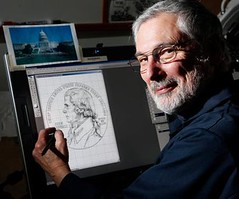 John Mercanti's title at the U.S. Mint in Philadelphia is chief engraver, but it's a little inaccurate. For one thing, no human at the Mint has actually engraved anything for years.
John Mercanti's title at the U.S. Mint in Philadelphia is chief engraver, but it's a little inaccurate. For one thing, no human at the Mint has actually engraved anything for years. This is a time of transition for the design and sculpture department at the Mint, where centuries-old techniques are slowly — and not always easily — giving way to incredibly sophisticated computer technology.
So think of Mercanti as an artistic director — one whose standards are so high that the very first thing you see when you get off the elevator by his office is the giant head of Michelangelo's David.
"It's an amazing piece," Mercanti says. "Sometimes my sculptors will come out and they'll just stand in awe of the thing."
Got a quarter in your hand? Look to see if there's a P on it, right there behind Washington's ponytail. That's the Mint mark for Philadelphia. Once upon a time, Mercanti actually stamped those on by hand.
But the steel punches that made their mark on U.S. coins have long ago been replaced by computers. Mercanti's not nostalgic for the old days; he's open to inspiration from the most unlikely sources, like ... Shrek.
That's right: Shrek. It was a DVD special feature that convinced Mercanti to call in a Hollywood special effects expert to come teach the Mint's artists how to sculpt in virtual reality. Don't worry about ogres on your coins, though. Remember that head of Michelangelo's David in the hallway? It's not just an inspiration; it's a test.
"Every new apprentice or young sculptor that comes in," Mercanti says, "that statue will be taken from the hallway, will be set in the office next door, and that person will sit at the computer and sculpt it. And until they sculpt it, they cannot move to the next level."
Phebe Hemphill's cubicle is decorated with action figures, some of which she sculpted herself. Like a lot of artists here, she used to work in the toy industry. On her easel sits a fat plaster disc, about the size of a dinner plate. It's the sculptural model of the congressional gold medal for the Tuskegee Airmen.
The figures on the model are swathed in texture. Feathers, leather, facial hair — even a lamb-skin collar. Hemphill uses a variety of tools she's collected over the years to create the different effects.
"I have all these weird dental things that you probably don't want to go near," she laughs as she digs through a drawer full of pointy tools. "You can do anything if you just get a pattern down."
A couple of computer monitors lurk at the other end of her desk, but Hemphill prefers to sculpt with traditional tools before converting her work to digital.
Medallic artist Joe Menna prefers sculpting with a stylus rather than menacing dental tools. He demonstrates by scraping virtual ridges into a portrait of William Henry Harrison on his monitor.
"You can see that I'm removing material, just as if I were carving it in clay," he explains. His boss calls Menna the "Yoda" of this technology.
Menna says the technology, with its ability to zoom in on tiny detail or create any texture, gives him ultimate aesthetic control. And it's actually changing him as an artist.
"The cool thing about working digitally is I can just 'control-Z' — I can just hit the undo button, and it all goes away." He taps his keyboard.
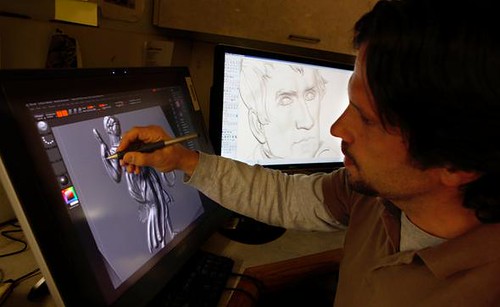
He's so used to sculpting digitally he's found himself reaching for phantom control-Z buttons even when actually working in clay. "Somewhere the wires are connecting upstairs, and I guess I'm evolving with this technology — or devolving, I don't know." He laughs.
Menna's enthusiasm for the technology has been gaining converts at the Mint. And there may come a day when there is no more clay and plaster here. But Mercanti knows the important things will endure.
"I'm committed to using classical techniques," he says. "Even though we're moving into the digital era, we still maintain the classical psychology."
And if Mercanti's artists are ever tempted to stray, there's that imposing enforcer in the hallway — Michelangelo's David.
To read the complete article (and listen to the segment), see: Sculpting The Digital Dollar (www.npr.org/templates/story/story.php?storyId=103013029)
Check out the photos here! www.npr.org/multimedia/2009/04/mint/
COIN WORLD ON ELECTRONIC PUBLISHING OF NUMISMATIC LITERATURE
Coin World's subscribers can remain totally in the paper-print dimension or they can tip-toe into the digital world gradually. Or, they can take the big leap and go totally digital. To each his own.
For numismatic bibliophiles, the future is likely to encompass electronic book devices, also known as e-readers.
Amazon says that already more than 250,000 books plus U.S. and international newspapers and magazines can be downloaded. We're not aware of any numismatic titles currently available on Kindle 2. However, as e-readers evolve (as color becomes available and costs decrease - Kindle 2 currently retails for $339), we predict a stampede.
Imagine having your entire numismatic library on an e-reader, being able to take it with you anywhere, and being able to key-word search any of your books within seconds. Such is not wishful thinking. The technology exists. It's only a matter of time before numismatic books and periodicals migrate to e-readers.
To read the complete article, see: The dinosaur on your coffee table (www.coinworld.com/articles/2009_0414/dinosaurs.aspx)
NEW E-BOOKS: KRAUSE PUBLICATIONS' WORLD COIN MICRO-CATALOGS
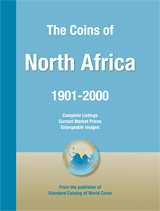 The Coins of North Africa 1901-2000
The Coins of North Africa 1901-2000 by Colin R. Bruce II and Thomas Michael
However you go about your coin collecting, you'll find key identifying details including mintage, metal composition, weight and obverse and reverse image descriptions, to accurately identify and assess your North African coinage in The Coins of North Africa. Pages are both searchable and enlargeable up to 400% for close-up inspection.
To order, see: www.shopnumismaster.com/product/57/25
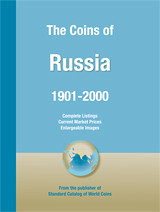 The Coins of Russia 1901-2000
The Coins of Russia 1901-2000 by Colin R. Bruce II and Thomas Michael
To order, see: www.shopnumismaster.com/product/54/25
MORE ON THE DIGITAL DILEMMA
Nancy Green (former ANA Librarian) writes:
Tim L. Shuck of Ames, IA writes:
Mr. Waterson notes that digital archiving requires periodic data migration and software/ hardware maintenance to keep the data usable. That's certainly true though I'm not sure if he regards that as a problem or is simply providing information. But preservation of paper materials also requires constant vigilance and expenditures of effort, time, and money. Is there a substantive difference between digital and paper archiving in this regard? The benefits of digital information are obvious; after all, the E-Sylum comes to my inbox, not my mailbox.
I think the 'debate' of paper vs. digital, if one exists, is ultimately fruitless. Each has advantages and disadvantages and neither is likely to replace the other anytime soon, though I think the trend is obvious. I happen to like the new digital version of Coin World, one of the most full-featured and capable digital implementations I've seen and used. And, I can save it as a pdf file if I choose to do so (83.5 Mb for the April 13 issue, in case you wondered). My paper copy gets passed along to others, and I have a digital copy on my computer for active or archival use - seems like a win-win to me, not a dilemma.
ARTICLE PROFILES THE 1968 PENNY MAN
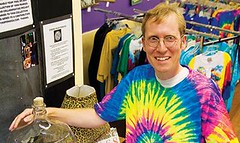 Gregor Brune needed cheering up when he found a 1968 penny during a walk 10 years ago in Lawrence, Kan. (pop. 80,098). He pocketed the lucky penny-and has had the good fortune of collecting nearly 13,000 more with help from donors across the country.
Gregor Brune needed cheering up when he found a 1968 penny during a walk 10 years ago in Lawrence, Kan. (pop. 80,098). He pocketed the lucky penny-and has had the good fortune of collecting nearly 13,000 more with help from donors across the country."I'd like to see how many I can get and keep the collection going indefinitely," says Brune, 42, a librarian and history buff who became fascinated with the year 1968 while growing up and hearing stories from his mother, Caroljean Brune, about the 1960s counterculture movement and listening to her music.
"I'd go through my mom's record collection, and I noticed that many of my favorite albums were produced in 1968," Brune says of music by the Beatles, Janis Joplin, Jimi Hendrix and the Rolling Stones. "I thought there was something special about that year."
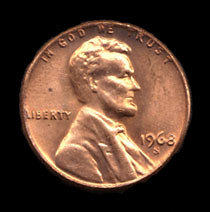 Brune's appreciation for 1968 as a pivotal year in history grew as he learned more about the year's events: anti-war protests, political upheavals, the Apollo 8 moon mission, and the assassinations of Martin Luther King Jr. and Robert F. Kennedy.
Brune's appreciation for 1968 as a pivotal year in history grew as he learned more about the year's events: anti-war protests, political upheavals, the Apollo 8 moon mission, and the assassinations of Martin Luther King Jr. and Robert F. Kennedy.Naturally, his favorite year came to mind in 1999 when he stumbled upon a penny while walking on a downtown sidewalk and mulling over some personal problems. "I thought, 'If that penny is a 1968, it'll be a confirmation that everything will be OK.'"
Good fortune found Brune that day! He dropped the lucky penny in a jar and thereafter checked the date on every penny that came his way. In two years, he had collected about a hundred 1968 pennies, and friends began adding to his coin collection. To thank them, Brune created a website in 2004 with names of contributors, a current tally of pennies and a 1968 history lesson, which he gleaned by reading the entire year of 1968 Time magazines, week by week in chronological order.
"It gave me a hobby," he says.
Brune's happenstance hobby has turned into a passion-some might say an obsession-for 1968 pennies. Every Wednesday, he buys 50 rolls of pennies at Lawrence Bank and spends three hours checking them for 1968s. He usually finds 15 to 20. Each day, he opens his Post Office Box 1968 and retrieves five or six cents sent from contributors like Astrid McMullen-Baker, 27, of Madison, Wis., one of Brune's former co-workers.
To read the complete article, see: The Pennies of 1968 (www.americanprofile.com/article/33012.html)
To visit the web site: www.1968pennies.com/
To read the earlier E-Sylum item, see: A VERY SMALL WANT LIST - 1968 LINCOLN CENTS (www.coinbooks.org/esylum_v10n49a31.html)
NEW LINCOLN CENT DESIGNS SLOW TO ENTER CIRCULATION
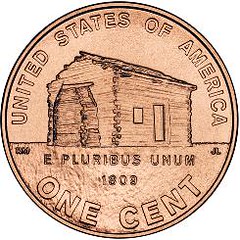 The penny, often picked on for its piddly value, has found some self worth in 2009. The 2009 Lincoln cent — slow to spread into consumers' pockets — is being sold for big bucks. Single coins have fetched more than $1 each. Fifty-cent rolls have frequently ranged from $2 to more than $50 at online auction websites.
The penny, often picked on for its piddly value, has found some self worth in 2009. The 2009 Lincoln cent — slow to spread into consumers' pockets — is being sold for big bucks. Single coins have fetched more than $1 each. Fifty-cent rolls have frequently ranged from $2 to more than $50 at online auction websites.The first of four new penny designs officially launched on Feb. 12 — Abraham Lincoln's birthday — but the 634.8 million coins produced by the U.S. Mint have barely made it into circulation.
The penny distribution "is slow-going," says Mint spokesman Greg Hernandez. "Because of the downturn and the lower demand for coins (for business transactions), banks are not demanding as many coins," he says. "As a result, the Federal Reserve has a pretty large inventory."
The sense of rarity has made the coin seem much more valuable, says Dave Harper, editor of Numismatic News.
To read the complete article, see: New penny's slow start in circulation increases value (http://www.usatoday.com/money/industries/banking
/2009-04-13-new-penny-higher-value_N.htm)
AUSTRALIAN SHOPKEEPERS WANT TO DITCH THE NICKEL.
Nearby New Zealand has already abolished the 5-cent coin -- in 2006 -- so it is not that Australia would be the first, but would be the largest country to effect the economies of realistic value of their lowest coin in circulation. Citizens have called the 5-cent coin "shrapnel" as it fills their pockets and is tossed aside at the end of the day.
There is an optimum number of coin denominations in circulation for any country. As economies advance the need for very low value coins diminishes -- 10c, 50c, $1, $2 and $5 coins would be the optimum denominations to fill five-compartment cash registers around the world. We wonder how long it will be before Americans come to this realization.
To read the complete article, see: Shopkeepers and retailers say five cent coins should be scrapped (http://www.news.com.au/business/story/0,27753,25354376-462,00.html)
RAE V. BIESTER, PHILADELPHIA MINT SUPERINTENDENT
Here's a fun video worth checking out: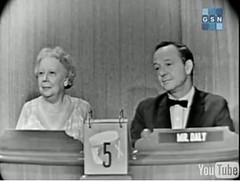 Some of us (cough) are old enough to remember What’s My Line, if only in reruns. It was a TV game show where a panel would ask questions of a mystery guest attempting to guess their occupation. Over the years the composition of the panel changed, but this episode includes regulars Kitty Carlisle and Tom Poston.
Some of us (cough) are old enough to remember What’s My Line, if only in reruns. It was a TV game show where a panel would ask questions of a mystery guest attempting to guess their occupation. Over the years the composition of the panel changed, but this episode includes regulars Kitty Carlisle and Tom Poston.To read the complete article, see: What Was Her Line in 1958 (http://coinsblog.blogspot.com/2009/02/what-was-her-line-in-1958.html)
ANOTHER SOLAR-SYSTEM MEDAL
Inspired by our recent discussion on medals depicting solar eclipses, Dick Hanscom forwarded these photos of a related medal. He writes: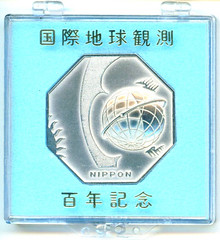
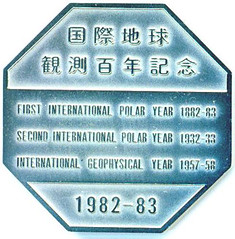
To read the earlier E-Sylum article, see: MORE ON COINS AND MEDALS DEPICTING SOLAR ECLIPSES (www.coinbooks.org/esylum_v12n15a07.html)
BOOK LOOTED IN CIVIL WAR RETURNED TO LIBRARY AFTER 145 YEARS
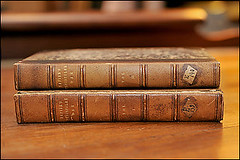 Soon after the end of the Civil War, a thousand or so books looted from Washington College library during a raid by Union soldiers were returned.
Soon after the end of the Civil War, a thousand or so books looted from Washington College library during a raid by Union soldiers were returned. Another has shown up almost 145 years later, the school, now known as Washington and Lee University, announced yesterday, brought in by a book-loving college coach from Illinois, who inherited it from the soldier's descendants and tracked down the library where it belonged.
"We were astounded to get something back with the history that it has," said Laura Turner, technical services librarian at the Lexington, Va., school. "It's invaluable to us because of the historical connection to the university. We're just so grateful that he decided to return it."
The leather-bound book, Volume 1 of a four-volume history of a Napoleonic military campaign, probably was stashed in a saddlebag, perhaps to save it from the blaze Union soldiers set to destroy the neighboring Virginia Military Institute on June 12, 1864, according to a book dealer who helped the coach, Mike Dau, unravel its story.
In June 1864, in the midst of the Civil War, Maj. Gen. David Hunter led troops assigned to cut the Virginia Central Railroad. On June 11, they swept into Lexington and occupied the town. They burned the Virginia Military Institute, which trained Confederate troops, and looted the neighboring Washington College campus.
Goodheart contacted Turner, and they exchanged photocopies of the title pages of the two volumes. "They matched exactly," Turner said. There was also a small label, added by the library in the 1800s, when books were numbered instead of catalogued to keep track of them. Volume 1, in Dau's possession, was 139. Volume 2, the copy in the library, was 140.
"Volumes three and four are out there somewhere," Turner said with a laugh. "We'd love to have them back!"
To read the complete article, see: Long-Wayward History Volume Has Quite a History Itself (www.washingtonpost.com/wp-dyn/content/article/2009/04/15/AR2009041502000.html)
FEATURED WEB SITE: ISLAMIC BANKNOTES
This week's Featured Web site is the Reference Site for Islamic Banknotes.This site was initially developed by Armen Hovsepian and Peter Symes, but we are interested in expanding the content and detail of the pages.
As long as there is support from the collecting public, we expect that we will go a long way towards achieving this.
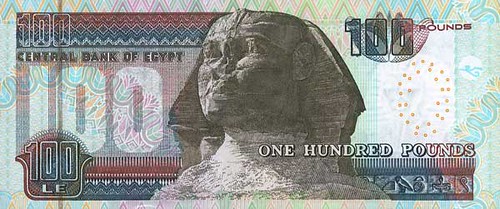
www.islamicbanknotes.com
